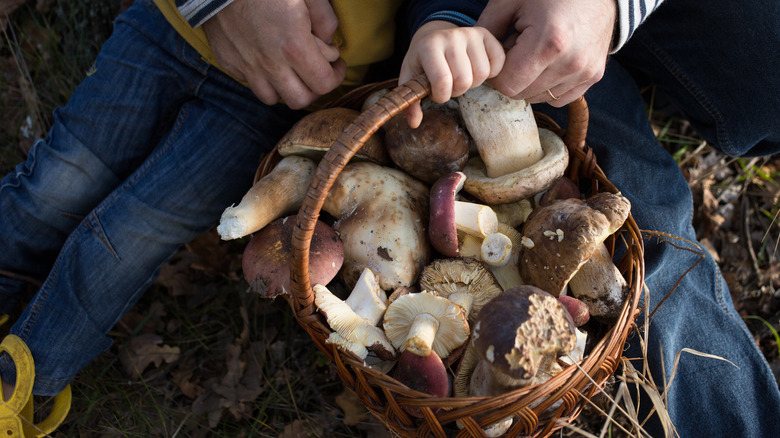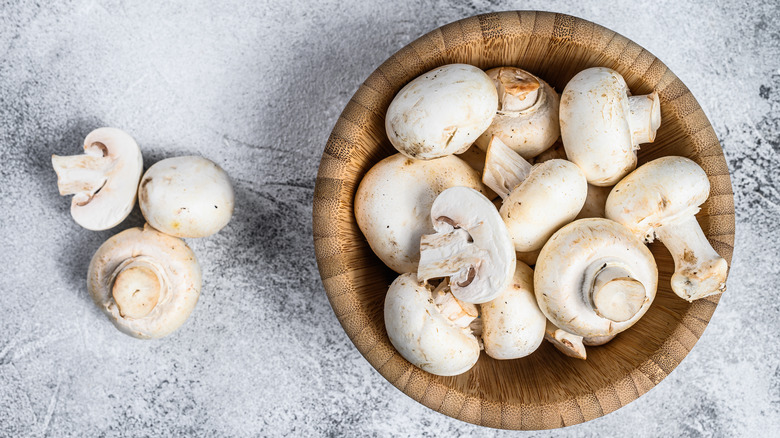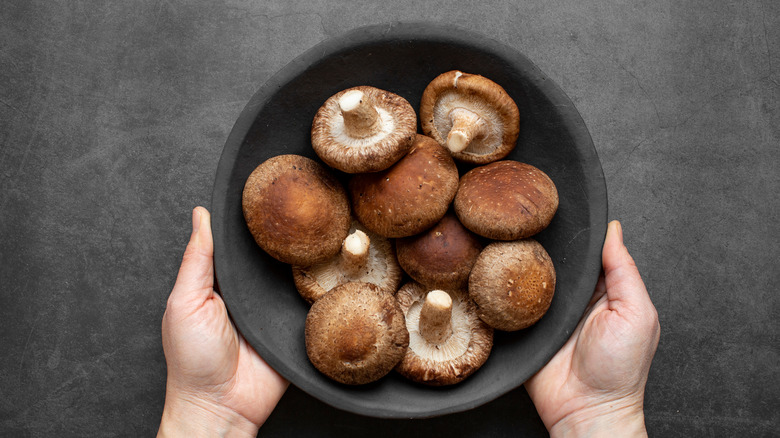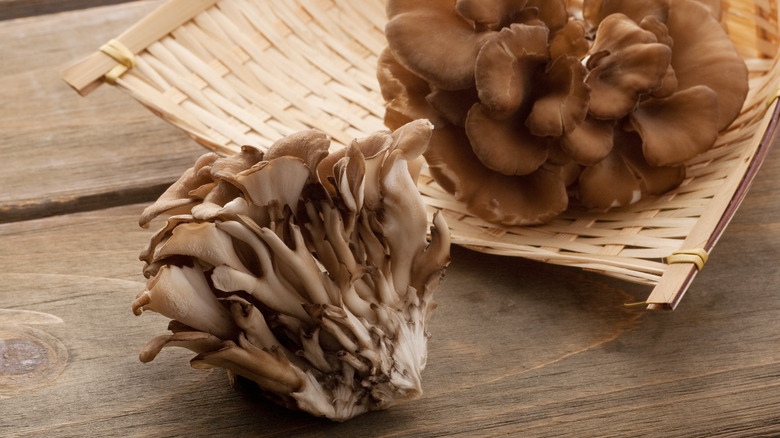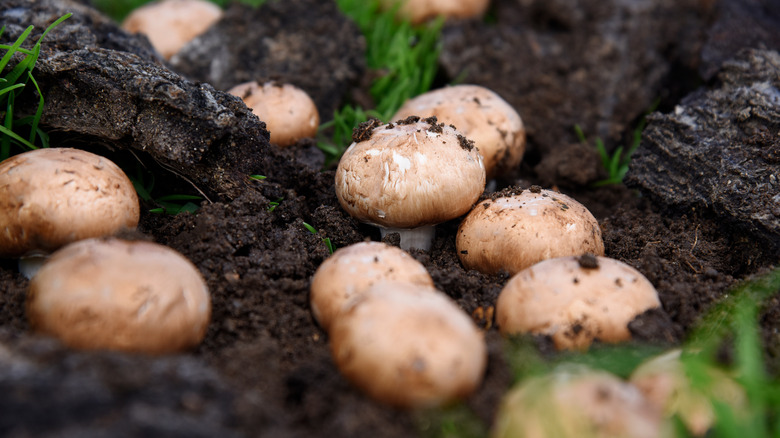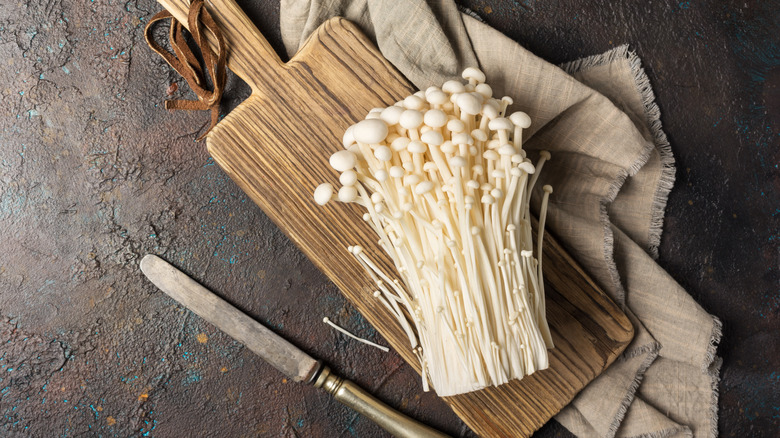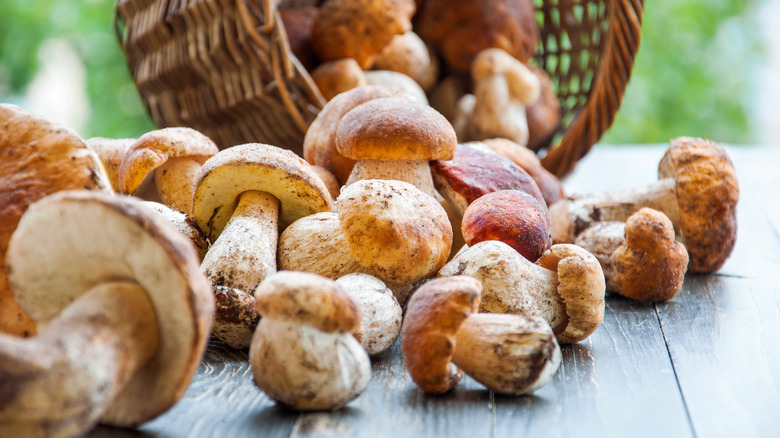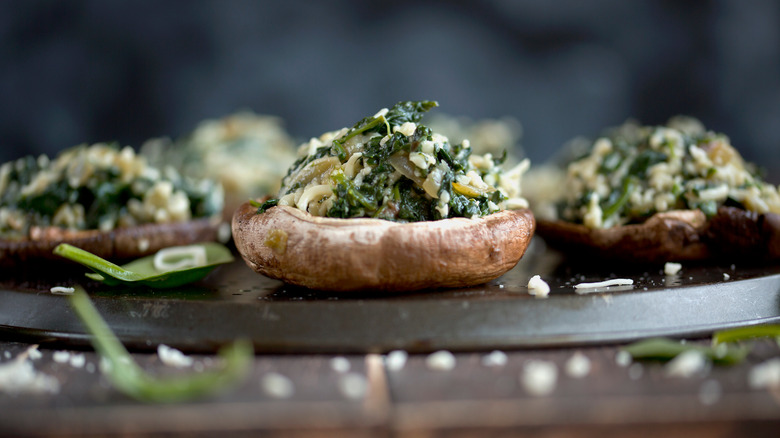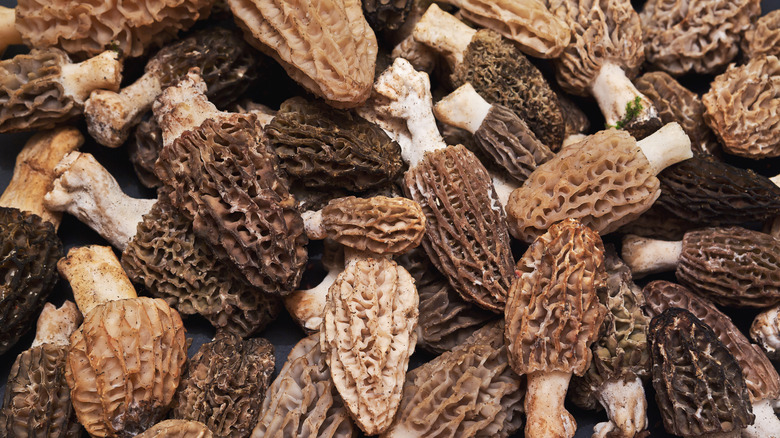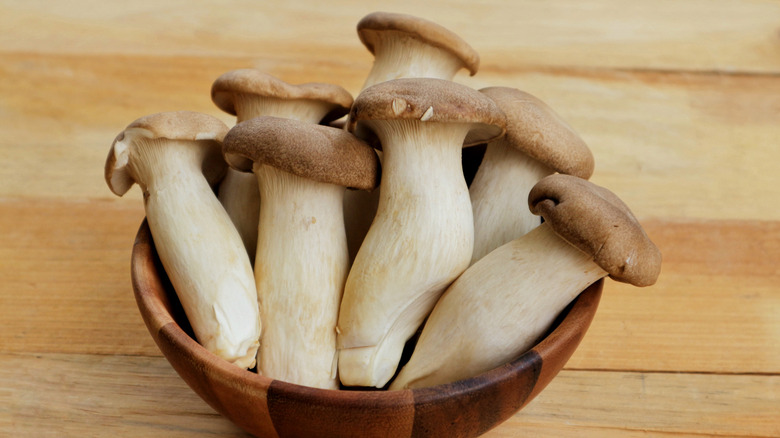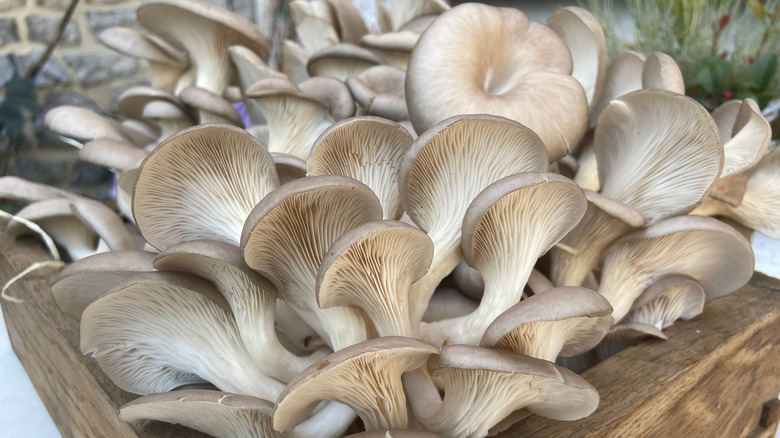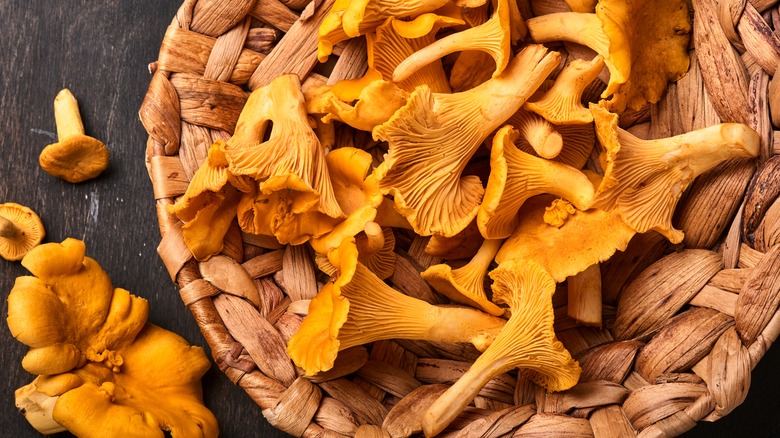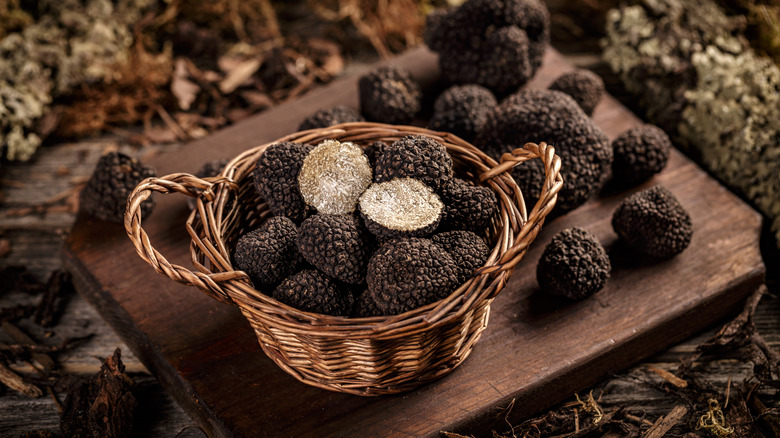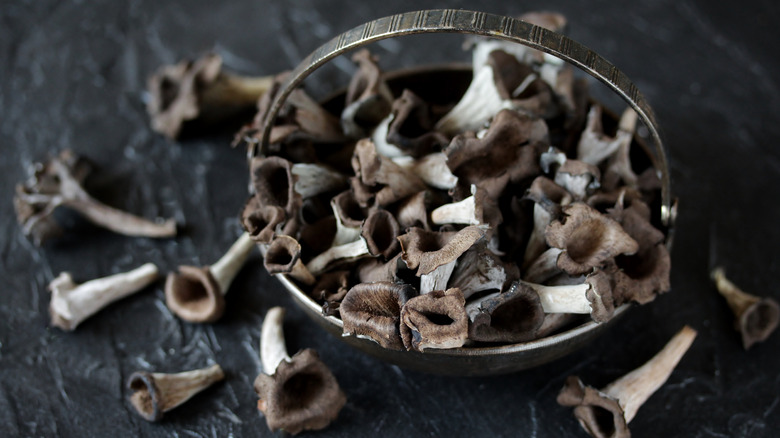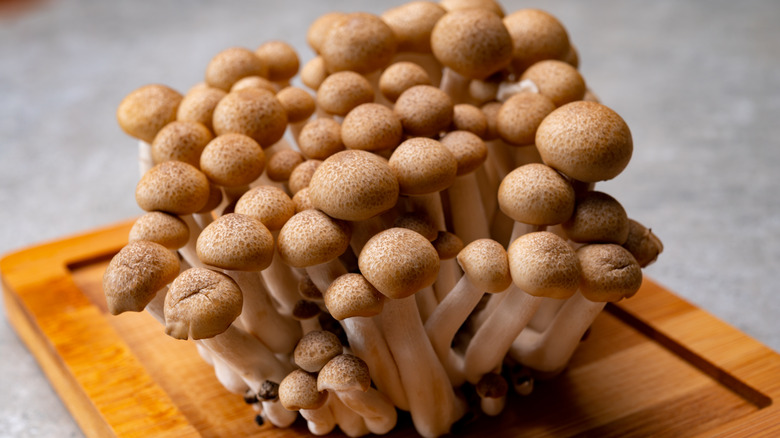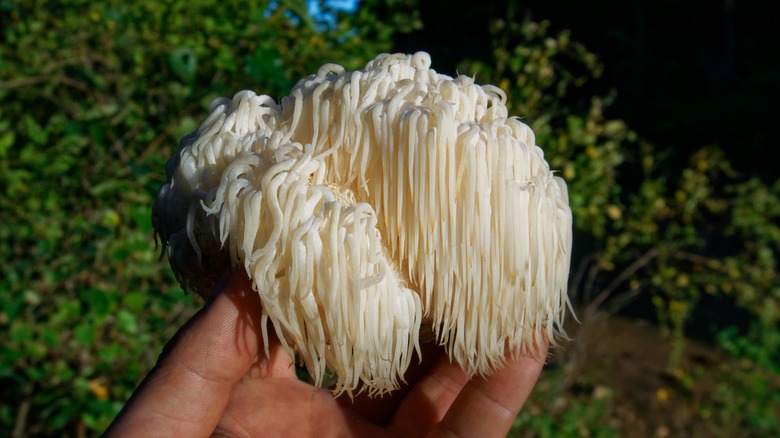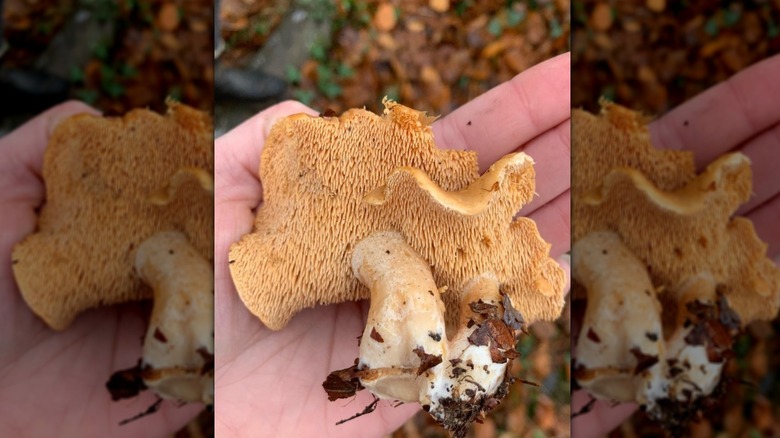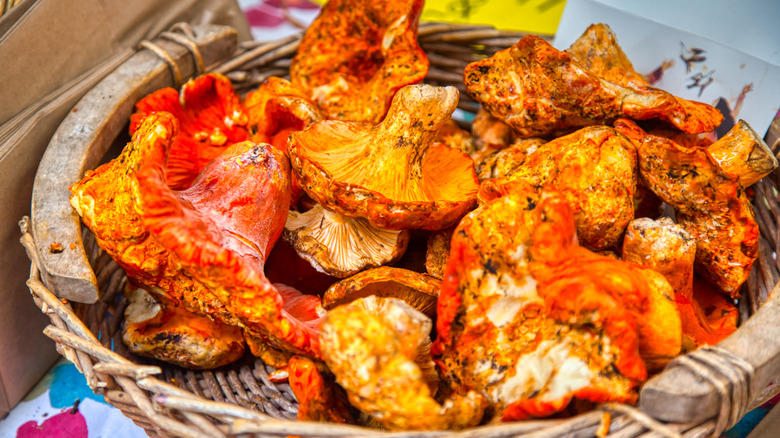17 Types Of Mushrooms And How To Best Cook Them
For some people, mushrooms are a luxury. Their earthiness and meaty textures make them a go-to kitchen staple for those who love rich, intense flavors and chewy bites that bring something special to a dish. For others, though, mushrooms are a no-go. If you fall into the latter category, it may just be because you haven't yet tried a variety of mushroom that you really like.
See, in the U.S., a massive portion of the mushrooms we eat all come from the exact same species. And if you've only had these types of mushrooms for your whole life, we can understand how you wouldn't be fond of them. But, in reality, there are so many different types of mushrooms to choose from, and they all boast different textures and flavor profiles.
That's why we've decided to round up some of our favorite mushroom varieties. We're covering the classics, of course, but we also want to give some of the more under-the-radar mushroom species the recognition and praise they deserve. Give these mushrooms a try if you've never had them before, and you might just have a new favorite food on your hands. Let's take a closer look.
Button mushrooms
If you've only ever had one type of mushroom in your life, we're going to assume that you had a button mushroom. This variety of mushroom is very common, and it's probably what you see whenever you're in the produce section at your grocery store. Actually, button mushrooms are the same species as cremini and portobello mushrooms (we'll get to those later), but they are just harvested at an early point in their growth cycle. The result is a mild, somewhat unremarkable flavor.
Because they don't have a super strong flavor, they're often used for their texture. They can be added raw to a salad, and their somewhat tough and chewy texture makes for an interesting addition to a plain plate of lettuce. When they're sautéed or grilled, the flavor becomes deeper and richer, making them better for sauces or even as a side dish. We suggest adding plenty of spices and herbs to button mushrooms if you don't want them to come out bland.
Button mushrooms are a solid option when you're looking for something quick, easy, and affordable, but if you're not a fan, you should definitely branch out and try other options out there.
Shiitake mushrooms
If you're familiar with Asian cuisines, you may have come across shiitake mushrooms before — they're common in a variety of East Asian dishes. Some believe that they have medicinal benefits, which means that they often make an appearance in healthy soups. They look different than what you may be used to if you're usually a button mushroom person: Shiitake mushrooms have thin stems and wide caps that have an umbrella shape to them.
Wondering how they taste? They're not super strong, so they're great for beginners, but we also think that they tend to be more flavorful than button mushrooms. Shiitake mushrooms have a woodsy, earthy taste to them when eaten raw, but when cooked, they take on a rich umami flavor that tastes amazing in a variety of dishes. They're commonly sautéed, or you can easily add them to soups, but shiitakes also taste good fried and roasted. Add them on top of a pizza if you want to take your pie to the next level.
Maitake mushrooms (hen of the woods)
While some varieties of mushrooms are easy to find at your local grocery store, others are not quite so simple to locate. If you have a well-stocked farmers market in your area that sells mushrooms, you're in luck and can probably find maitake mushrooms, also often referred to as "hen of the woods." Otherwise, you may only see this kind of mushroom in the woods. It's very important that you don't harvest mushrooms from the wild if you do not have intimate knowledge of fungi, as many mushrooms can be extremely poisonous. But who knows? You may be able to spot some the next time you go for a hike if you bring a reliable guidebook.
Some people may not appreciate the flavor of maitake, but we think it has a lovely, subtle meaty quality to it that pairs well with a wide range of foods. They're found in clusters, and the tops of the mushrooms form a feathery pattern. These mushrooms are particularly good sautéed, and we love adding them to a stir-fry for a meat-free alternative.
Wondering where you can find them in the wild? Maitake mushrooms appear globally, including in the U.S. and Canada, as well as in China, Japan, and across Europe.
Cremini mushrooms
We've already learned about button mushrooms, but what about cremini mushrooms? They're also known as baby bella mushrooms, and they're the same species as button mushrooms, but they're just harvested later in the growing process. Because they've been allowed to mature for longer, they're meatier and more savory than their younger cousins. For this reason, we tend to prefer cremini mushrooms over white button mushrooms (but if you're not already a big mushroom person, the opposite may be true for you).
These are also extremely versatile mushrooms, so they can be used in most recipes that call for mushrooms. You can eat them raw in a salad if you tend to like them uncooked, but they take on a whole different dimension when they're sautéed, roasted, or grilled. And if you're on the hunt for the perfect mushroom for a creamy, savory risotto, you may just have found what you're looking for in the cremini.
Enoki mushrooms
If you're not already a fungi fanatic, then enoki mushrooms may seem just plain strange. But stick with us here: These are actually some of our favorite mushrooms out there, and we think you'll like them too if you give them the chance. They have long, thin stalks that branch together in a bunch. Those stalks have tiny, button-like caps on top. You don't eat these mushrooms one at a time — rather, you eat one of the bunches at a time.
Enoki mushrooms are commonly used in a variety of Asian cuisines. You can cook the bundle of mushrooms in a variety of ways, or you can leave them completely raw if you want to add a nice touch of crunchiness to a salad or veggie dish. However, they're also really delicious in soups and shabu shabu. Cook them down until they're nice and tender, and they make an amazing addition to a bowl of brothy noodles.
Want to cook your enokis on a skillet? We advise getting them nice and brown with plenty of crunchy edges. This makes your mushrooms sweeter and offers some extra sweetness to the flavor.
Porcini mushrooms
If you're a fan of French or Italian cuisine, then you may have come across porcini mushrooms at some point in your culinary journey. Porcinis are thick, hearty, and meaty, which makes them excellent as a meat replacement or in dishes that require plenty of cooking time. They have a woodsy flavor to them that's a little more intense than many of the mushrooms on this list. It's definitely a mushroom-y mushroom (if that makes sense), so it may not be our first choice for beginners. For the seasoned mushroom lover, though, porcinis are the way to go.
Wondering how to cook them? Porcinis make an excellent addition to a risotto recipe, as they will hold their shape and texture better than many other, less hearty mushrooms. They also make an excellent addition to soups and stews. You'll often find dried porcini mushrooms, which can easily be reconstituted in dishes such as braised brisket.
Portobello mushrooms
From the same species as the button mushroom and cremini mushroom, portobello mushrooms are simply harvested later than the other two, which is why they're so much bigger than their cousins. Since they have grown the longest of these three varieties, they have the strongest and most intense flavor. However, because portobellos are used so commonly in so many dishes, most people shouldn't find the flavor itself too unappealing. And if you usually love the richness and umami flavors of mushrooms, then portobellos should be some of your favorites.
These mushrooms are notable for their size: They're considerably bigger than most other mushrooms on this list. The stems are often trimmed, and you're just left with a large cap. We love slicing and sautéing the cap, but it's also amazing just thrown on the grill as it is with a little marinade if you want to make a portobello mushroom burger recipe.
When you're looking for a hearty mushroom that has a wide appeal, portobellos will always be there for you.
Morels
Now we're getting into the luxury mushroom category. If you love fungi, you've probably heard of morels before. These are some of the most sought-after mushrooms in the world thanks to their deep, nutty flavor and unique spongy texture. Morels are also some of the most expensive mushrooms on the market. This is because they're not cultivated domestically — the only way you can get them is by going out in the wild and picking them yourself. But, you should not do this if you're not an expert!
You may have only seen them on the menus of your favorite restaurants, but you can sometimes find them at farmers' markets if you're lucky. Once you get your hands on them, you may feel like you're under pressure to make them as good as they can be. Keep things simple: Sautéing morels in butter will bring out their natural, nutty flavor, and you'll get the chance to enjoy them all on their own.
King oyster mushrooms
We have to confess that king oyster mushrooms, also sometimes known as trumpet or king trumpet mushrooms, are some of our favorites. If you've ever had one, you probably already know why. These odd-looking mushrooms pack a ton of flavor into every bite, and it's almost uncanny how meat-like the texture is. The texture is akin to seafood, like scallops or calamari. The stem on these mushrooms is large and dense, and although you can eat the cap too, it really is the star of the show.
While you may tend to think of mushrooms as side dishes, trumpet oysters challenge that assumption. Because of their texture and their striking appearance, they make an excellent main course for vegetarians and omnivores alike. We think that they're amazing when they're seared or grilled and seasoned generously with salt and oil. Don't be afraid to treat these mushrooms like meat if you really want to make a standout dish.
Oyster mushrooms
Here's another favorite of many: the very delicious oyster mushroom. They get their name because of their caps, which are similar in color and in shape to oysters. These mushrooms grow in clusters, which we love, because the thin edges of each individual mushroom can get nice and crunchy when you employ certain cooking techniques. Similar to the king oyster, this type of mushroom has a slight seafood flavor to it. The flavor is delicate and mild, but it's more complex than many other types of mushrooms. While the appearance of oyster mushrooms can turn some people off, the taste is sure to be a crowd-pleaser.
Wondering what to do with oyster mushrooms once you get your hands on some? We love them as a simple sautéed side dish, but you can also add them to pasta and risotto to provide an interesting texture. Oyster mushrooms are incredibly versatile, so if you can think of something that might pair well with them, you're probably right.
Chanterelles
If you want a mushroom that's going to be a showstopper before you ever take a single bite, you can't go wrong with chanterelles. These mushrooms have a gorgeous yellow-orange hue to them that's so bright, you might think that these were poisonous if you didn't know better. Chanterelles generally grow in the wild, but you may be able to find them for purchase at some specialty stores or farmers markets. Since they're not the most common mushrooms around, you may have to pay a premium for them, but we guarantee that they're worth the splurge if you can manage it.
When you first bite into a chanterelle, you'll notice a deeply woodsy flavor. If you're not used to eating a lot of mushrooms, it may not be your style, but for those who love eating mushrooms, it's sure to be a hit. Since they are so flavorful on their own, you can simply sauté some chanterelles in butter for a glorious side dish. If you choose to add them to another dish, just make sure that they get the spotlight they deserve. You don't want to hide a fungus this beautiful.
Truffles
When you think of a high-end mushroom, what first comes to mind? If you're like a lot of people, you'll think of truffles. Truffles may have been overplayed on many menus in recent years, but your disdain for truffle-less truffle oil or truffle fries shouldn't keep you from enjoying the real thing. Fresh truffles really are something amazing.
There are three different varieties: white, black, and burgundy. They all offer slightly different flavors, and they're all available at different times of the year. Truffles only grow in the wild, so they can be prohibitively expensive. If you can get your hands on some, though, you'll see what the hype is all about.
This type of fungus is unlike any other mushroom on this list. You won't want to cook it at all, as that can ruin the truffle's delicate taste. Rather, you'll want to shave it over top of pasta or other dishes. You'll be amazed at the amount of flavor the truffle imparts. Since truffles can be quite expensive, they're not exactly an everyday thing, but they can take a special dinner to a whole new level.
Black trumpet mushrooms
Never had a black trumpet mushroom before? The first time you see it, you may be surprised by the color: This fungus really is black. But, when you take a closer look, you'll see that it doesn't have a structure that's too far off from an oyster mushroom or a chanterelle (it's sometimes called a black chanterelle). We love black trumpet mushrooms because of their rich, concentrated taste. In fact, they're so flavorful that they even taste similar to a black truffle (according to The Cook's Cook, they're known as the "poor man's truffle" in Eastern Europe).
Black trumpets are available dried but they're delicious when they're fresh too, though, which means that they make an excellent addition to a stir-fry. They can be a bit delicate, so you won't want to apply really intense heat for too long. You'll find these mushrooms growing in the woods as well, particularly if you live in the Midwest or the East. They typically pop up in late summer, so keep your eye on the trail the next time you go for a hike during August and September.
Brown beech mushrooms
Brown beech mushrooms are often also found in Asian cuisine, but they can be used in an incredibly wide range of dishes. That's because of their mild flavor and generally pleasant texture. Although they come clustered together in a bunch, they're easy to separate into small, separate mushrooms that make excellent additions to stir frys, risottos, pastas, and other dishes. The flavor of brown beech mushrooms is nutty and buttery. Keep it simple by steaming or sautéing these versatile mushrooms, or make a rich butter sauce for them to bathe in. You can eat them raw — they have a lovely crunchy texture that makes an excellent addition to salads. Speaking of salads, a pickled beech mushroom addition will add some welcome brininess.
Brown beech mushrooms are an excellent option for those who are trying to branch out and try new varieties of mushroom. The texture isn't too intimidating, and the flavor is light and pleasant.
Lion's mane mushrooms
Lion's mane mushrooms aren't something you see every day, but when you do get the chance to check one out, you'll be amazed. You've probably never seen a mushroom like this before: Basically, it resembles what a weeping willow would look like if it were a small fungus. It's incredibly recognizable, and as it grows in North America, Europe, and Asia, there's always a chance you can come across it on a hike. With its distinctive look, you'll have no problems spotting it.
While this strange-looking mushroom may not appear to be edible, you can totally eat it. The taste is subtle and almost seafood-like. The inside of the fungus is quite meaty, making it a fantastic meat substitution. As long as the little strands are white, they're edible too, and they can get nice and crispy when you sauté them.
Lion's mane may not be for everyone, but if you want to try something completely different, you should try to get your hands on some. You won't be disappointed!
Hedgehog mushroom
It can be difficult to identify many wild mushrooms because they share so many similarities with others. This can cause a problem for foragers because dangerous, poisonous mushrooms can look quite similar to the edible varieties listed here. However, hedgehog mushrooms are generally easier to identify than many of their cousins. They have a brown cap with almost tooth-like structures hanging from the underside — of course, you're still not going to want to pick wild hedgehog mushrooms if you're not already an experienced forager and have a trusty guide.
These hedgehogs are similar to chanterelles, but you'll notice a marked difference in flavor. Hedgehog mushrooms tend to have more of an earthy, smoky taste than chanterelles. Because their flavor is so distinctive, there's not much you have to do in the kitchen to make them into an enjoyable snack or side dish. Try frying them in oil or butter so you can get them nice and crisp, or add them to your pizza or pasta dish for an earthy punch.
Lobster mushrooms
Why are they called lobster mushrooms? Take a closer look, and you'll notice that they do, in fact, have that signature orangey red color than lobsters are known for. However, you shouldn't be expecting too much a seafood-like experience when you take a bite out of a lobster mushroom. In fact, you shouldn't expect a normal mushroom experience either, since lobster mushrooms are a bit different than many of their counterparts on this list. That's because this mushroom isn't technically a mushroom. Instead, it's a mold that infects other mushrooms and gives them their iconic coloring.
Sure, that may not sound too appealing, but mushroom-loving chefs adore lobster mushrooms, and they can make for a delicious addition to dinner. Apart from their appearance, they do have a texture that's similar to seafood — if you like that chewiness of shellfish, you're likely to enjoy lobster mushrooms as well.
To get the most flavor out of every bite, you'll likely want to sauté or pan fry these mushrooms so they can soak up some fat and get richer and creamier. Feel free to add them to other dishes, where they can provide a pop of color, or enjoy them on their own so you can truly appreciate the taste of this hard-to-find fungi.
